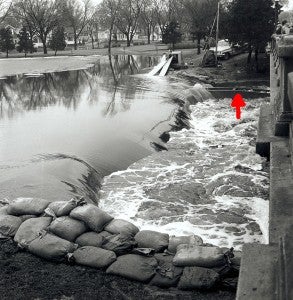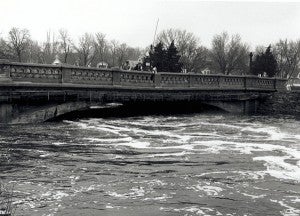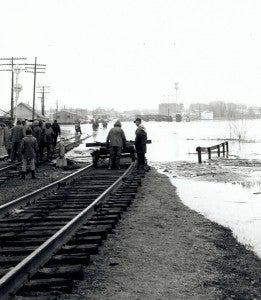St. Patrick’s Day blizzard of 1965
Published 10:00 am Saturday, March 19, 2011
St. Patrick’s Day 1965 should have been a good day for wearing green. Yet, the overwhelming color that particular day was white as one of the most significant blizzards in many years struck the Freeborn County area. In fact, the March 17 blizzard was the third major storm in 1965, a year when all too much snow and an early spring thaw were to create serious flooding problems less than a month later.

Here’s pictorial proof that there was all too much water in Fountain Lake in early April 1965. At that time 46 years ago the dam at the outlet of the lake had an added feature called a fish ladder, highlighted in the photo with an arrow. There was an opinion this fish ladder hindered the water flow over the spillway and this part of the dam was removed a year or two later. -- Photo courtesy Freeborn County Historical Museum
A lack of snow cover and colder than average temperatures had been the prevailing weather conditions in early 1965. This caused the frost to go even deeper into the soil. Such a situation can cause most of the winter’s moisture to become runoff and cause flooding instead of going into the soil during the spring thaws.
The first real blizzard came in mid-February and caused some traffic problems. This was followed with a warming trend and even a rainstorm later in the month, which filled the ditches with excess water and caused some minor flooding in low-lying areas.
On March 2, the temperatures dropped and another blizzard disrupted traffic and caused electrical power outages in the Armstrong-Conger and Glenville-Myrtle areas. These two blizzards were just preliminary events for an even more spectacular winter storm that was yet to come.
The March 17, 1965, issue of the Tribune said, “The traditional March snowstorm that usually comes during basketball tournament time moved into Albert Lea and other points in Minnesota today — St. Patrick’s Day.”
Heavy snow driven by 60 mph winds that also picked up the snow from the March 2 blizzard clogged highways, blocked railroads and closed schools and business firms for several days. Within the city, the storm created 6-foot-high drifts, isolated the Shoreland Heights neighborhood, and caused major blockages of streets and highways with abandoned cars and trucks.
One example of the storm’s intensity was featured in the March 18, 1965, issue of the Tribune with a short article about the Kiester Ambulance Service and its emergency trip to bring a patient from Walters to Naeve Hospital in Albert Lea. It took the ambulance crew four hours to make the 27-mile trip.
Electrical power was disrupted for periods ranging from several hours to several days for residents in the Alden, Geneva, Ellendale, Hollandale and Maple Island areas.
Still another snowstorm swept across the state just before the end of March 1965. The snowfall totals for this month thus ranged from 37 to 50 inches in the southern part of Minnesota. This was reportedly the greatest accumulation of snow for the month of March since 1951.

This photo taken by the late Ken Wangen in early April 1965 helps to emphasize just how much water was flowing under the Bridge Avenue Bridge into the place known as the “Channel.” -- Photo courtesy Freeborn County Historical Museum
The accumulation of excess snow resulting from the four February and March storms sitting on the deeply frozen ground began to cause concerns for authorities and citizens that another serious spring flood season could come if there was a sudden warming trend or early April showers.
Those April showers can result in flowers later in the spring, and as the people of Freeborn County and especially Albert Lea quickly discovered in 1965, those same rains and a sudden warming trend could also result in serious flooding and traffic problems.
As the consequence of four winter storms in February and March 1965, including the big blizzard on St. Patrick’s Day, the deeply frozen land and lake surfaces of Freeborn County had an excess of available moisture. Slight flooding conditions had occurred in late February during an earlier thawing period. In the first week of April, warmer temperatures and rain started a real spring thaw that quickly resulted in an overwhelming surplus of water.
The level of Fountain Lake rose several feet within a few days. By April 7, Katherine Island was completely covered by water which also stood on the deck of the small access bridge to the depth of an inch or two. Streets bordering on the lake had water over the surface in low spots and the basements of many nearby homes were flooded.
City authorities became concerned because of the amount of water going over the spillway of the dam at the outlet of Fountain Lake. Sandbags were piled on each side of the spillway to prevent a washout. By April 8, the depth of the water exiting the lake was 45 inches over the top of the spillway.
Under normal conditions there is a five foot difference in elevation between Fountain Lake and Albert Lea Lake. The flood conditions in April 1965 reduced that difference to about a foot.

Another photo by the late Ken Wangen shows a crew of men preparing to work on the flooded tracks of the Chicago Rock Island and Pacific Railroad east of Newton Avenue in early April 1965. In the background is the Wilson & Co. plant. -- Photo courtesy Freeborn County Historical Museum
As Albert Lea Lake in turn filled with excess water, flooding caused real problems along East Main Street. At that time this street was the designated route through Albert Lea for east-west traffic on U.S. Highway 16, and north-south traffic on U.S. Highway 65. (This was the era before Interstates 35 and 90 were completed and few alternate routes were then really available.) State patrol and city police officers set up a detour using the Main Street Bridge, Katherine Street for eastbound traffic, Shell Rock Street for westbound traffic, and portions of Bridge Avenue and Clark Street as temporary routes around the worst of the flooded area. Even this routing resulted in vehicles going slowly through several inches of water. This detour was used for several weeks until the water levels receded.
The high water conditions resulted in six inches of water inside the Union Center, then located at 404 E. Main St., despite sandbagging to try to protect the building. State Highway 13 northwest of Albert Lea was covered with water in several places. Lakeview Avenue in Shoreland Heights near the entrance of Edgewater Park was flooded. The KATE transmitter tower south of the city was isolated by high water. Frozen culverts added to traffic problems as nearly all the low lying areas and ditches in Freeborn County filled with water. Seven or eight families were evacuated from their waterlogged homes on the south side of Abbott Street and east of Dane Bay. Other families there and elsewhere in the city somehow managed to cope with water problems in and around their homes.
The flooding conditions resulted in waist deep water over the mainline of the Chicago Rock Island and Pacific Railroad. During the worst of the flooding the railroad managed to move trains through Albert Lea by pushing cars from one end through the water to a dry stretch on the other side where switch engines could then hook on and slowly pull the passenger and freight units over the weakened roadbed. Within a few days large work crews used tons of gravel to reinforce the roadbed.




